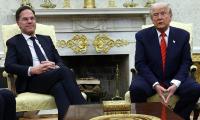There is substantial evidence that an IMF bailout merely sets countries up for repeat bailouts. Some countries, like Rwanda and Liberia, have been under continuous IMF tutelage since their independence six decades ago. Low-income countries that have not fallen out of favour politically with the West have been engaged with the IMF on average for 45 years. They have experienced an average of 16 IMF programs and interventions. For low-middle-income countries, these numbers are 40 and 14 respectively. Pakistan has been under IMF tutelage since 1958. Over this period, it has experienced 30 IMF loans and interventions.
It is well known that the IMF is very influential in the economic and social fate of low- and middle-income countries. Less well known is the fact that since 2008 this influence has grown astronomically. As low- and middle-income countries started building up their foreign exchange reserves to avoid bailout conditionalities, by December 31, 2007 the IMF’s portfolio size had shrunk to $9 billion from $34 billion in 1984.
Via domino effects, the 2007-2009 financial and economic crises even impacted high income countries like Ireland, Portugal, Spain and Greece, and so the G-7 decided to expand the IMF’s portfolio size. There was another boost to this portfolio size to deal with the Covid-19 supply chain shocks and those that followed Russia’s invasion of Ukraine. By December 31, 2022 the outstanding IMF credit was $113 billion, about a 13-fold increase from 2007 in nominal terms.
Recent empirical research on the IMF’s effectiveness in promoting economic growth is inconclusive while earlier research showed it had a negative growth impact. An analysis of IMF programmes shows that there is no economic growth theory embodied in its programs. At best, IMF-led reforms lead to stabilization and a one-time boost to economic growth. However, programme conditionalities are often at cross-purposes. For example, devaluation, interest rate hikes and import liberalization will lead to difficulties in meeting fiscal, balance of payment and inflation targets. On balance, these conditionalities prove to be anti-growth and anti-development and so it is not surprising that countries are unable to graduate out of IMF tutelage.
The key focus of IMF programmes, not surprisingly for a financial institution making loans, is to make countries solvent. This serves the interests of creditors including the IMF, the World Bank and key high-income country shareholders.
Economic logic suggests that attaining economic sovereignty from the IMF is the only path to catch-up growth. While it has been argued that the IMF is ‘the only game in town’, countries like Japan, Korea and Taiwan have shown there is an alternative. All of them managed to build up their FOREX reserves to attain their economic sovereignty and pursued a market friendly developmentalist approach that has proved to be much more effective in attaining catch-up growth and development.
Developmentalism evolved as a conceptualization of the Japanese economic practice which began in the 1950s. It was honed and enhanced from the 1960s to the 1980s, based on local conditions by Korean and Taiwanese economic practice, and again conceptualized by several scholars as an alternative to neo-liberalism.
Developmentalism, unlike the IMF’s neo-liberal approach, embodies a growth theory. Growth, if the approach is successfully adopted, comes from a focus on technology. The successful adoption of developmentalism requires a continuous move up the value chain. This in turn comes from building indigenous technological capacity that becomes endogenous to the growth process.
Another good reason to pursue this alternative approach is that, while recent evidence on the IMF’s impact on economic growth is mixed, the evidence that it has a negative impact on poverty and inequality is overwhelming. All the countries that have pursued developmentalism have a much lower incidence of poverty and inequality than conventional capitalist economies.
After decades of social criticism, a very sophisticated IMF public relations campaign has tried to persuade critics that it has changed and that now it is sensitive to poverty, inequality and the environment. Once again, the evidence is overwhelming that austerity rules as a hard target and social development sacrificed as a soft target. The leopard has not changed its spots.
While neoliberalism has a penchant for rolling back the state, developmentalism is a market friendly approach guided by the state. In this regard, there is a natural synergy of developmentalism with climate friendly development via an appropriate technology policy.
To sum up, in terms of attaining economic growth, poverty eradication, ameliorating inequalities and addressing the climate change challenge, developmentalism is more fit for purpose than the IMF imposed neoliberalism.
The writer is a US-based economist and a former executive director of SDPI.
People of that time believed that an eclipse was a symbol of displeasure of gods
Vertically speaking, dominance of domestic debt in Pakistan’s debt portfolio is haunting
Loss of biodiversity is stark reminder that urban mismanagement is not just infrastructural failure but ecological...
Strong public warning systems can also help ensure quick evacuations in places prone to fires
PPPs in Pakistan's WASH sector face significant regulatory and policy challenges that hinder their effectiveness
Instead, it would have powerful chairman with three-year term, appointed at prime minister’s discretion







